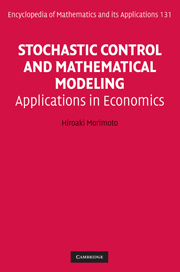Book contents
- Frontmatter
- Contents
- Preface
- Part I Stochastic Calculus and Optimal Control Theory
- Part II Applications to Mathematical Models in Economics
- 6 Production Planning and Inventory
- 7 Optimal Consumption/Investment Models
- 8 Optimal Exploitation of Renewable Resources
- 9 Optimal Consumption Models in Economic Growth
- 10 Optimal Pollution Control with Long-Run Average Criteria
- 11 Optimal Stopping Problems
- 12 Investment and Exit Decisions
- Part III Appendices
- Bibliography
- Index
12 - Investment and Exit Decisions
from Part II - Applications to Mathematical Models in Economics
Published online by Cambridge University Press: 07 September 2011
- Frontmatter
- Contents
- Preface
- Part I Stochastic Calculus and Optimal Control Theory
- Part II Applications to Mathematical Models in Economics
- 6 Production Planning and Inventory
- 7 Optimal Consumption/Investment Models
- 8 Optimal Exploitation of Renewable Resources
- 9 Optimal Consumption Models in Economic Growth
- 10 Optimal Pollution Control with Long-Run Average Criteria
- 11 Optimal Stopping Problems
- 12 Investment and Exit Decisions
- Part III Appendices
- Bibliography
- Index
Summary
In this chapter, we study the decision problem of investment rates and exit times for a private business in a stochastic environment. We consider a competitive firm that produces a capital good with the capital stock K(t).
The market price P(t) of the capital good is governed by a stochastic differential equation, and the market value of the capital given by X(t) ≔ P(t)K(t). The net cash flow of the firm coincides with the profit rX(t) for the profit rate r net the total cost ϕ(q(t))X(t) of investment q(t)K(t). The firm sells its whole business at any time τ, given a resale value function g(·), when the integration of capital goods is costly. The firm's fundamental value is the total of the net cash flow and its abandonment payoff g(X(τ)). The objective of the firm is to find the investment rate q*(t) and the exit time τ* simultaneously, which maximize the expected fundamental value.
We solve the nonlinear variational inequality associated with the firm's value maximizing problem. The optimal policies are shown to exist from the optimality conditions.
The Model
Consider the decision problem of investment rates and exit times. Define the following quantities:
P(t) = market price of the capital good at time t.
ν = expected decline rate of the price.
B(t) = the standard Brownian motion.
[…]
- Type
- Chapter
- Information
- Stochastic Control and Mathematical ModelingApplications in Economics, pp. 269 - 288Publisher: Cambridge University PressPrint publication year: 2010



